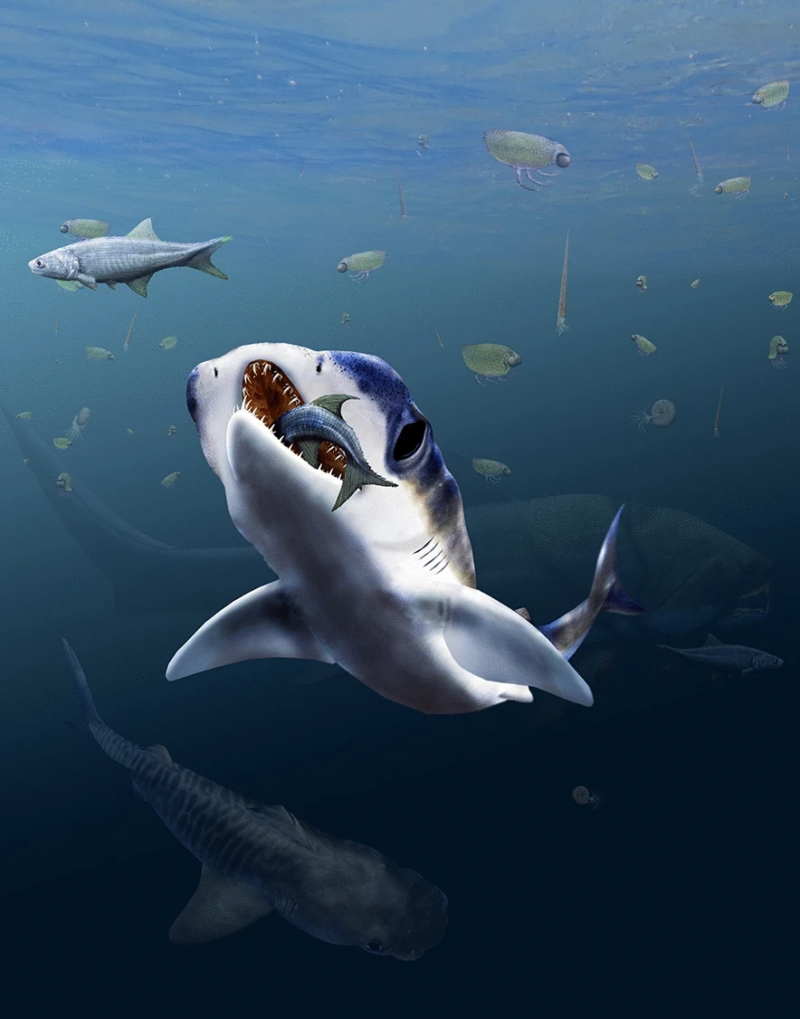
Sharks are largely cartilaginous, a body structure that often doesn’t survive fossilization. But in a paper published in the Swiss Journal of Paleontology, scientists describe an entirely new species of primitive shark from the Late Devonian period, a time when they were just beginning to proliferate in ancient oceans.
The team found several exceptionally well-preserved fossils that include soft tissues such as scales, musculature, digestive tract, liver, and blood vessel imprints. Also preserved: the species’ most distinct feature, widely separated nasal organs, somewhat akin to those on today’s hammerhead sharks. The find suggests that sharks’ finely tuned sense of smell, the subject of urban legends, was already being selected for just as these predators were becoming established.
A key time and a rare find
Christian Klug is the lead author and curator of the Paleontological Institute and Museum at Zurich University. He explained the significance of the Devonian period in the oceans’ history, when life was flourishing and an evolutionary arms race was in full swing. “With increasing competition among predators inhabiting the water column, the entire organism was selected for more efficiency,” he explained. “This affected swimming abilities, feeding apparatus, but also the sensory systems, which are essential to detect prey, to orient themselves in space, and to escape from even larger predators such as the huge placoderm Dunkleosteus and the equally large shark Ctenacanthus.”
That placoderm was arguably one of the most terrifying fish of the Devonian, as Dunkleosteus was an armor-plated tank with razor-sharp fangs and a deadly bite force.
The new fossils come from the Maïder and Tafilalt regions of the eastern Anti-Atlas of Morocco, a country with incredibly rich fossil deposits. Wahiba Bel Haouz is a co-author and geologist at the Faculty of Sciences, University of Hassan II Casablanca. She described a number of Moroccan locations “famous among fossil collectors,” including “the fossiliferous Devonian to Lower Carboniferous strata. Ammonoids, trilobites, brachiopods, fishes, corals, and trace fossils are locally so abundant that specific fossil beds have been mined over many kilometers, leaving marker trenches in the desert. Cephalopods are so abundant at many levels, even after decades of heavy commercial exploitation, that it is justified to call the region a ‘cephalopod paradise.’”
The new shark fossils were found in deposits filled with fossil mollusks, crustaceans, armored fish (placoderms), cartilaginous fish (acanthodian stem-chondrichthyans), and bony fish (actinopterygians and sarcopterygians). Unlike other fish found at this time and from most other localities, the fossils at this site weren’t flattened by millions of years of geologic pressure.
The team named this new shark species Maghriboselache mohamezanei, a nod to the country where it was found and one of the people responsible for finding it. (The phrase “al Maghrib” is Arabic meaning “Morocco”; “selachos” is Greek for “cartilaginous fish”; and “mohamezanei” is in honor of Moha Mezane, a self-taught geologist who not only found a number of the specimens described in this paper, but other important fossil discoveries as well.)
The exceptional preservation, combined with a CT scanner, provided an exceedingly rare three-dimensional skull that offered scientists a view into the neurocranium of a fish that lived approximately 350 to 383 million years ago. They were surprised to discover that it had widely spaced nasal capsules (the nostrils and the internal tube connected to it).
The smell of the ocean
These nasal capsules are “really surprising and exciting,” said Abdelouahed Lagnaoui, the co-author of this paper and professor of stratigraphy and paleontology at the Ecole Supérieur de l’Education et de la Formation, Université Hassan Premier de Berrechid. This, he said, “is an unknown feature in other contemporary or subsequent Palaeozoic sharks and might even be the earliest instance in all jawed vertebrates (gnathostomes).”
Most sharks, even today, have nasal capsules spaced closely together. One significant exception is the hammerhead, whose cephalofoil—the flattened, hammer-shaped head—contains a nasal capsule on either side.
We are still learning about olfactory capabilities in extant sharks, but one hypothesis proposes that having nasal capsules spaced widely apart enables a shark to pinpoint odors with more precision. The spacing is thought to enable it to determine which side a smell is stronger on, allowing the fish to turn toward it. This is otherwise known as the ability to smell in stereo, a capability, the team suggests, that Maghriboselache may have had, even if the nasal capsules were not as far apart as today’s hammerheads.
Finding a fossil such as Maghriboselache “helps us get to the question of form and function,” Aubrey Clark, a sensory biologist and PhD student at Florida Atlantic University, said. “Because in a fossil, you see form, but you may not necessarily know the function.”









